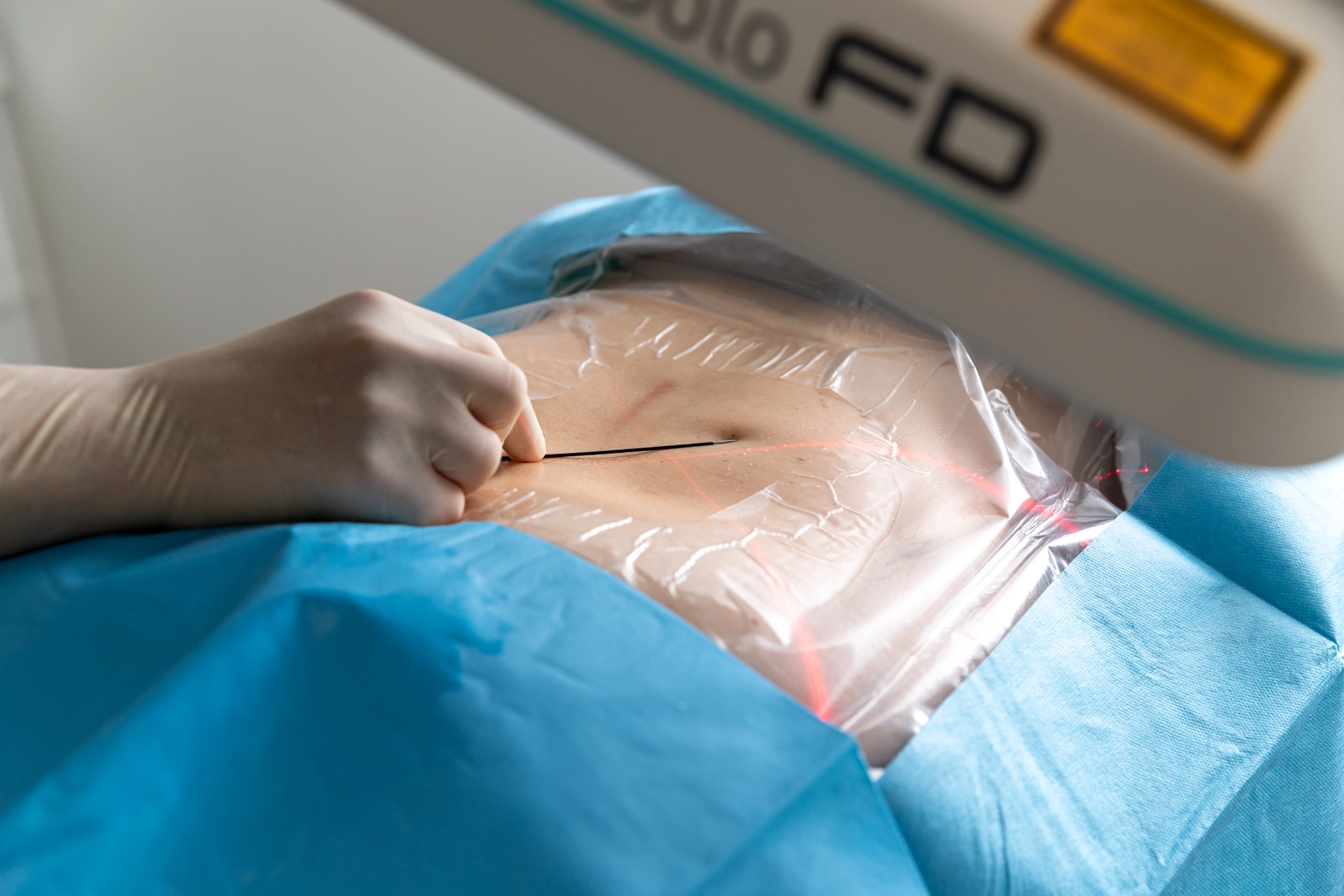Neuromodulation: Innovative Approaches to Chronic Pain

SCS influences the transmission of neural impulses using electrical signals. This procedure is minimally invasive, non-destructive to tissue, and reversible.
The choice of neuromodulation depends on various factors and is made in a stepwise manner within an interdisciplinary team. The main indications include neuropathic pain, chronic spinal disorders, postoperative pain, and peripheral arterial occlusive disease (PAOD).
Neuromodulation is often considered symptomatic treatment since chronic pain is frequently incurable. The primary treatment goals are:
- Significant pain reduction
- Improved quality of life
- Reduction in medication use
- Retention of work capability
The aim of SCS is to influence and suppress pain signals at the dorsal horn of the spinal cord. This is achieved through electrical impulses delivered via cylindrical electrodes (less commonly paddle electrodes) placed in the epidural space. The impulse generator (IPG), similar to a pacemaker, stimulates the dorsal column, which transmits pain signals from the periphery to the central nervous system.
A wide range of stimulation programs exist, varying by manufacturer. These are broadly divided into two main categories:
- Low-frequency stimulation with tingling paresthesias
- High-frequency stimulation without sensory side effects
SCS is suitable for the following pain conditions:
- Therapy-resistant back pain (PSPS Type 1)
- Pain after spinal surgery (PSPS Type 2/FBSS)
- Complex Regional Pain Syndrome (CRPS)
- Peripheral and central neuropathic pain (e.g., radiculopathy, polyneuropathy)
- Peripheral arterial occlusive disease (PAOD)
The treatment is conducted in two stages:
Trial Phase (SCS Trial):
- Minimally invasive placement of electrodes
- A trial period of 1 to 4 weeks to evaluate efficacy
- Outpatient adjustment of stimulation parameters
Permanent Implantation:
- Performed only if significant pain reduction and improved quality of life are observed
- The neurostimulator is implanted under the skin in a second surgery
If the trial phase is unsuccessful, the electrodes can be easily removed.
Possible complications include:
- Bleeding or nerve injury
- Electrode displacement
- Infections or lead fractures
- Loss of stimulation effectiveness
In addition to SCS, alternative procedures include:
- Pulsed radiofrequency treatment
- Peripheral nerve stimulation (PNS)
- Dorsal root ganglion stimulation (DRG stimulation)
- Occipital nerve stimulation (ONS)
- Intrathecal pain pumps
Neuroablative techniques, such as thermoablation and cryoablation, are also options for pain management.
Subscribe to Newsletter
We’d be happy to share more about us and our services in the next newsletter and on www.issz.ch.
Current Affairs
Further News & Publications

Facet-related back pain – a common but hard-to-recognise cause
Facet-related back pain – a common but hard-to-recognise cause Back pain is among the most common complaints in our society. One often overlooked cause is

Team – Dr. med. T. Tessmann #NewDoctor #NewPainSpecialist
From June, Dr. Tobias Tessmann will join ISSZ. He already worked as a resident in anesthesiology at Spital Lachen from 2019-2021 together with Dr. J.

Certification as an SSIPM Training Centre Pain Clinic B
We recently announced that we would apply for certification as an SSIPM training centre “Pain Clinic B”. We are now very pleased to have received

Cooperation with the Institute for Interventional Pain Medicine Zurich AG (IISZ)
Similar to the long-standing, close friendship and professional relationship between Jan Ludwigs and Daniel Friis, the connection between the ISSZ and the Institute for Interventional

Suzetrigin: A Novel Pain Medication in Switzerland
Suzetrigin (brand name: Journavx™) is an innovative, non-opioid analgesic that was approved in January 2025 by the U.S. FDA for the treatment of moderate to

Pulsed Radiofrequency Treatment (pRF)
Die gepulste Radiofrequenz-Behandlung (pRF) stellt eine minimalinvasive, nicht-destruktive Methode zur Behandlung
chronischer Schmerzen dar. Im Gegensatz zur thermischen Radiofrequenzablation, die durch Hitzeeinwirkung Nerven

Facet-related back pain – a common but hard-to-recognise cause
Facet-related back pain – a common but hard-to-recognise cause Back pain is among the most common complaints in our society. One often overlooked cause is

Team – Dr. med. T. Tessmann #NewDoctor #NewPainSpecialist
From June, Dr. Tobias Tessmann will join ISSZ. He already worked as a resident in anesthesiology at Spital Lachen from 2019-2021 together with Dr. J.

Certification as an SSIPM Training Centre Pain Clinic B
We recently announced that we would apply for certification as an SSIPM training centre “Pain Clinic B”. We are now very pleased to have received

Cooperation with the Institute for Interventional Pain Medicine Zurich AG (IISZ)
Similar to the long-standing, close friendship and professional relationship between Jan Ludwigs and Daniel Friis, the connection between the ISSZ and the Institute for Interventional

Suzetrigin: A Novel Pain Medication in Switzerland
Suzetrigin (brand name: Journavx™) is an innovative, non-opioid analgesic that was approved in January 2025 by the U.S. FDA for the treatment of moderate to

Pulsed Radiofrequency Treatment (pRF)
Die gepulste Radiofrequenz-Behandlung (pRF) stellt eine minimalinvasive, nicht-destruktive Methode zur Behandlung
chronischer Schmerzen dar. Im Gegensatz zur thermischen Radiofrequenzablation, die durch Hitzeeinwirkung Nerven